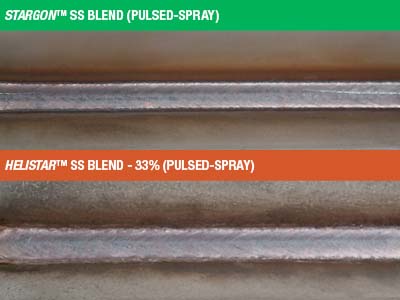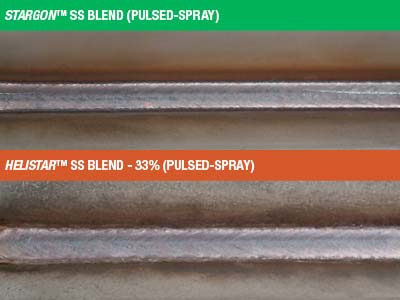Returning to Super Metal Status
From surgical instruments to chemical plant pressure vessels, stainless steel has reigned as king in the manufacturing and fabrication world for more than a century. The metal is seemingly indestructible but can be challenging to fabricate unless you follow a few simple rules. While naturally resisting corrosion and rust, stainless steels are sensitive to how they are handled in the fabrication process.

The use of the proper tools and procedures will go a long way toward conquering the challenges associated with welding stainless steels. Stargon™ SS shielding gas blend – Praxair's proprietary blend of argon, carbon dioxide and nitrogen – is one of those tools that can help solve some of the problems associated with stainless steel MIG welding and provide a high-quality welded component.
The Challenges
One of the challenges when MIG welding stainless steel is the need to control heat input. It can affect the amount of distortion in the completed component as well as the quality and appearance of the finished weld. Excessively high heat input during welding can also contribute to the degradation of the base metal's properties, especially its corrosion resistance near the weld joint. Careful handling and treatment of stainless steel during and after the welding process is needed to prevent contamination of the weld joint and the potential loss of corrosion resistance.
Features and Benefits
Features and benefits of Stargon SS welding gas blend include:
- Readily available argon based blend – no helium
- Reduced flow rates
- 20% more product per cylinder and lower costs per cylinder
- Reduced weld metal carbon content for corrosion resistance
- Less post-weld cleanup
- Reduced heat input for less burn through and distortion
- Reduced heat-affected zone
- Light surface oxide and surface appearance
- Enhanced color matching
The Solution

Praxair's Stargon SS gas blend – an argon-based alternative to traditional helium-based blends – offers a cost-effective solution for welding stainless steel. It is a precisely controlled and unique blend of argon, carbon dioxide and nitrogen that is specifically designed for welding a wide variety of stainless steels using a range of welding parameters. Being an argon-based blend, it can produce a stable arc at voltages far below those required by high helium content blends.
This enhanced control over arc characteristics makes it possible to achieve higher weld travel speeds with reduced heat input resulting in less distortion and better weld color matching. According to Jeff Ingraham Business Development for StarSolver® and MPS at Praxair, Stargon SS welding gas blend can be just as critical to welding stainless steel as using the proper tools and procedures.
"We have found that across the board, from maintaining corrosion resistance to improving weld color matching, Stargon SS gas blend has helped our customers meet the quality demands of their final product," Ingraham said.
In addition to improved weld-ability, Stargon SS gas blend contains 20 percent more product per cylinder when compared with helium-based gas mixtures. Combined with the blend's ability to help the welder minimize potential stainless steel welding defects and help assure a higher quality weld, Stargon SS gas blend allows fabricators to reduce costs and make the most of their investment in stainless steel materials.




























